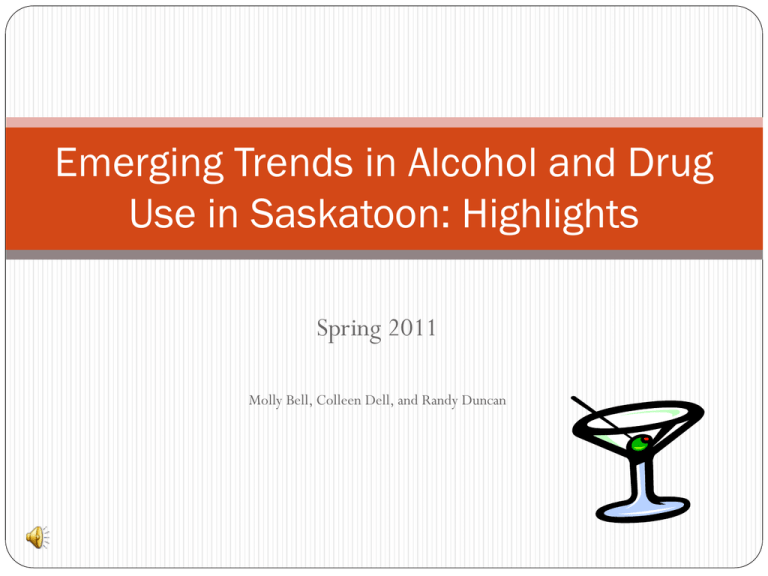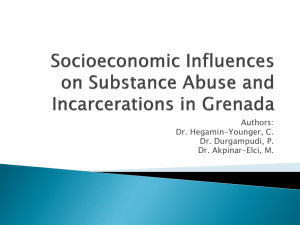
Emerging Trends in Alcohol and Drug
Use in Saskatoon: Highlights
Spring 2011
Molly Bell, Colleen Dell, and Randy Duncan
Project background
Canadian Community Epidemiology Network on Drug Use
(CCENDU): http://www.ccsa.ca/Eng/Priorities/Research/CCENDU/Pages/default.aspx
Drug & alcohol indicators
Prevalence
Enforcement
Treatment
Morbidity
Mortality
AIDS/HIV/HepC
IDU
Needle exchange
Methodology
114-item questionnaire completed by 51 key informants
during Winter/Spring 2011
Additional respondents were identified by the research team
and key informants
Respondents included emergency room physicians, public
health nurses, emergency medical (or ambulance) technicians,
addictions counselors, pharmacists, mental health specialists,
drug enforcement officers, social workers, drug users
Interpretation panel to verify the questionnaire findings
Existing sources of quantitative data also reported on
Saskatoon: Demographics
Largest city in Saskatchewan
~ 250,000 residents
~ 17,600 individuals of Registered
Indian Status
~17,000 immigrants
Saskatoon
Agriculture and mining are large
industries
The Saskatoon Health Region & University
of Saskatchewan are large employers
2010 unemployment rate was 4.3%
Social determinants of health
The social determinants of health are the economic and social
conditions under which people live and influence their
health.
A 2009 Saskatoon Health Region report identified significant
health disparities between affluent and low-income residents
in the city.
A large proportion of Saskatoon’s First Nations and Métis
populations live in low-income
neighborhoods, and face poorer
health status in comparison to the
rest of the city’s population.
Problematic substance use
Percent of key informants indicating a "very serious" or
"somewhat serious” problem for 13 substances
100
90
% of respondents
80
70
60
50
40
30
20
10
0
Substance
Cocaine/crack
Cocaine/crack
50
45
% of respondents (n=51)
40
35
30
25
20
15
10
5
0
Very serious
Somewhat serious
Not at all serious
Don't know
Cocaine/crack: Typical users
Cocaine/crack
100
90
% of respondents (n=47)
80
70
60
50
40
30
20
10
0
Females
(<19)
Males
(<19)
Females Males (19- Females Males (30- Females Males (50- Females
(19-29)
29)
(30-49)
49)
(50-69)
69)
(>70)
Males
(>70)
Don't know
Cannabis
Cannabis
60
% of respondents (n=50)
50
40
30
20
10
0
Very serious
Somewhat serious
Not at all serious
Don't know
Cannabis: Typical users
Cannabis
100
90
% of respondents (n=46)
80
70
60
50
40
30
20
10
0
Females
(<19)
Males
(<19)
Females Males (19- Females Males (30- Females Males (50- Females
(19-29)
29)
(30-49)
49)
(50-69)
69)
(>70)
Males
(>70)
Don't know
Opioid prescription drugs
Opioid Prescription Drugs
70
60
% of respondents (n=48)
50
40
30
20
10
0
Very serious
Somewhat serious
Not at all serious
Don't know
Opioid prescription drugs: Typical users
Opioid Prescription Drugs
100
90
% of respondents (n=42)
80
70
60
50
40
30
20
10
0
Females
(<19)
Males
(<19)
Females Males (19- Females Males (30- Females Males (50- Females
(19-29)
29)
(30-49)
49)
(50-69)
69)
(>70)
Males
(>70)
Don't know
Alcohol
Alcohol
80
70
% of respondents (n=43)
60
50
40
30
20
10
0
Very serious
Somewhat serious
Not at all serious
Don't know
Alcohol: Typical users
Alcohol
100
90
% of respondents (n=36)
80
70
60
50
40
30
20
10
0
Females
(<19)
Males
(<19)
Females Males (19- Females Males (30- Females Males (50- Females
(19-29)
29)
(30-49)
49)
(50-69)
69)
(>70)
Males
(>70)
Don't know
Prevalence: Additional information
Geographic distribution of problematic substance use
Cocaine/crack, methadone and non-potable substances a
particular concern for lower-income neighborhoods.
Alcohol, cannabis, opioid and non-opioid prescription drugs,
amphetamines, and ecstasy were identified a city-wide problems
Heroin, hallucinogens, steroids and solvents were not identified
as problematic.
Other substances of concern
Energy drinks and salvia
Enforcement
Controlled Drugs and Substances Act
Violations in Saskatoon (2010)
Importation, 1
Production, 13
Criminal Code Traffic Violations in
Saskatoon (2010)
Trafficking, 147
Posession, 779
Other
criminal
code
traffic, 95
Dangerous
operation of a
motor vehicle, 96
Impaired
operation of a
motor vehicle, 544
Enforcement
Increased trafficking in nearly all substances in Saskatoon, and
especially cocaine/crack, cannabis, opioids and ecstasy.
Factors cited as causes for the increase:
demand from consumers
availability from suppliers
poverty
lack of affordable housing
difficulty accessing treatment programs
Saskatoon’s healthy economy
Treatment: Demographics
Gender
Age
Youth
under 19
9%
Female
33%
Male
67%
Adults over 19
90%
Treatment
Key informants indicated an increase in individuals seeking
treatment in the past year.
Substances most frequently cited are alcohol, cocaine/crack,
cannabis and opioids.
Contributing factors:
Decreased health and wellness
Lack of affordable housing
Poverty
Typical treatment seekers were males
and females 49 years of age and under.
Morbidity
Key informants identified an increase in individuals seeking
medical care due to alcohol and drug use over the past year
Substances most frequently cited were alcohol, cocaine/crack,
cannabis, and opioids
Poverty was the most frequently identified cause
All age groups identified as seeking care, with males and females
49 and under cited most frequently
Mortality
Key informants identified an increase in substance-related
deaths over the past year in Saskatoon.
Substances most frequently cited are alcohol, cocaine/crack,
opioids and illicit methadone.
Males and females age 19 to
49 were the most frequently cited as
suffering drug-related
deaths.
All age groups were identified for
alcohol-related deaths.
HIV/AIDS/Hepatitis C
Injection Drug Use (IDU)
In 2009/2010, 14% of treatment admissions in Saskatoon
reported IDU in the past month.
Cocaine and morphine were the most frequently injected drugs reported,
followed by Ritalin© and Concerta©.
In 2009, 11,216 loose needles were recovered in Saskatoon neighborhoods
One-third of key informants identified an increase in IDU in Saskatoon
over the past year.
Cocaine/crack were identified most frequently, followed far behind by heroin
and methadone.
Typical injection drug users were identified as males and females 19-29,
followed by individuals 30 to 49 and youth under 19.
35% of informants believe there has been an increase in IDU associated
risky behaviours (e.g., needle sharing/reuse, unprotected sex) over the
past 12 months in Saskatoon, placing individuals at increased risk of
contracting HIV/AIDS & Hepatitis C.
Pregnancy
In 2009/2010, 4% of women admitted to drug
and alcohol treatment services in Saskatoon
were pregnant.
Key informants identified an increase in the
number of women who use substances during pregnancy.
Key respondents also identified an increase in pregnant
women accessing treatment, requiring medical care, being
involved with the law, and being HIV and Hepatitis C
infected.
Future Directions
Question:
What does this means for your work?
How can we address this?
Early detection and surveillance network established in
Saskatoon:
Google® group created to enhance information sharing and
communication among drug and alcohol use-related sectors
Contact Molly Bell at molly.bell@shaw.ca to join
Saskatoon CCENDU report available at:
http://www.addictionresearchchair.com/disseminating-knowledge/ccendu/
References
Needle Safe Saskatoon. (2010). 2010 Newsletter. Retrieved from:
http://www.aidssaskatoon.ca/web/sites/default/files/NSS%202010%20Newsletter%20FINAL.pdf
Opondo J. (2010). Saskatoon: Updated information on an HIV epidemic in the prairies. PowerPoint Presentation. Saskatoon.
Saskatchewan Government Insurance. (2011). 2009 Saskatchewan traffic accident facts. Regina. Retrieved from:
https://www.sgi.sk.ca/sgi_pub/road_safety/trafficcollisionstats/pdf/2009/TAIS2009section10.pdf
Saskatchewan Ministry of Health. (nd). Saskatchewan’s HIV strategy: 2010-2014. Regina: Ministry of Health. Retrieved from:
http://www.allnationshope.ca/Documents/hiv-strategy-2010-2014.pdf
Saskatchewan Ministry of Health. (2011). Community Care Branch, Community Program Profile 2009-10, unpublished. Regina:
Ministry of Health.
Saskatoon Health Region. (2009). 2009-2010 Annual Report to The Minister of Health. Saskatoon: SHR. Retrieved from:
http://www.saskatoonhealthregion.ca/about_us/documents/shr_annual_report_2009_10.pdf
Saskatoon Health Region. (unpub). Preliminary results from the 2009 Enhanced Street Youth Survey.
Saskatoon Police Service. (2010). Month-end and year-end crime statistics. Retrieved from:
http://www.police.saskatoon.sk.ca/pdf/Dec_Monthend_Detail.pdf
Saskatoon Regional Economic Development Authority. (2011). Business statistics. Retrieved from:
http://www.sreda.com/en/pages/354/business_statistics.html
Statistics Canada. (2007). Saskatoon, Saskatchewan (Code4711066) (table). 2006 Community Profiles. 2006 Census. Statistics
Canada Catalogue no. 92-591-XWE. Ottawa. Retrieved from: http://www12.statcan.ca/census-recensement/2006/dppd/prof/92-591/index.cfm?Lang=E
Statistics Canada. (2010). Labour Force Information. Catalogue no. 71-001-X. Ottawa. Retrieved from:
http://www.statcan.gc.ca/pub/71-001-x/71-001-x201003_eng.html









